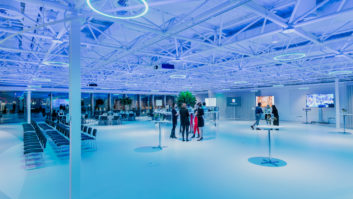 Throughout recent years, four physi-digi ‘mega-trends’ have dominated the audio-visual landscape. Challenges around creating a ‘hybrid world’, enabling ‘always-on collaboration’, building ‘seamless technology’, and reinforcing ‘mission-critical communication’ have impacted almost every type of organisation. And with hybrid living here to stay, they’ve highlighted our non-negotiable need for technology that breaks down walls, bridges gaps, and makes people feel closer together even when they’re far apart.
Throughout recent years, four physi-digi ‘mega-trends’ have dominated the audio-visual landscape. Challenges around creating a ‘hybrid world’, enabling ‘always-on collaboration’, building ‘seamless technology’, and reinforcing ‘mission-critical communication’ have impacted almost every type of organisation. And with hybrid living here to stay, they’ve highlighted our non-negotiable need for technology that breaks down walls, bridges gaps, and makes people feel closer together even when they’re far apart.
But as we move towards 2023, we’re beginning to see an evolution of these mega-trends in response to new challenges. So, let’s explore the latest patterns that managers, installers, and end-users should be aware of – and how you can harness audio-visual technology to get ahead of the curve.
ON THE HORIZON
One significant rising trend is the rapid expansion of video content. Studies show that every 30 days, more video content is uploaded to the internet than major US television networks have created in the last 30 years. As a result, displays are everywhere. And as they drop in price, and grow in resolution, reliability, and availability, video will only grow further. We’re living in the ‘age of video’, and managers wishing to keep pace with competitors must be ready to participate.
Meanwhile, the growth in open, scalable technology is leading to a convergence between the audio-visual and IT worlds. This includes advancements like AVoIP, and it’s impacting the responsibilities of system integrators, IT managers, and end-users – who should control an organisation’s audio-visual set-up? As AV roles and skillsets become much more IT-influenced, it’s likely to become IT’s domain.
We’re also seeing an increasing shift in value from hardware to software. The maturity of the hardware industry, improvements in internet connectivity, and the leaner nature of software creation mean it’s the area in which audio-visual innovation is likely to thrive. Business leaders and systems integrators should look out not only for hardware with software built-in, but products in which the software is actually operated from the cloud – enabling manufacturers to rapidly update, upgrade, and add value to the technology.
ECONOMIC STAGNATION
According to research firm Ned Davis, there’s now a 98% chance of a global recession, with multiple industries already feeling the squeeze. However, audio-visual technology has become such an important part of businesses’ day-to-day operations that AV is unlikely to face a decline.
In fact, we’re seeing encouraging improvements to supply chain issues that have plagued the industry over the past year, with prices for shipping, raw materials, and microprocessors returning to normal levels. For end-users, this means they can look forward to more innovative products, at increasingly affordable prices.
In terms of macroeconomics, Europe is the region most subject to an economic downturn. It’s also the continent that’s often the most conservative in terms of adopting new audio-visual technology. But as a result of the recession, we may see a wider global push towards ‘good-enough’ products – hardware and software that doesn’t offer any unique features or advantages, apart from their lower price. These products are even impacting the business model of systems integrators, as many can be installed out-of-the-box without professional support.
Managers and end-users should be wary of this trend. An assortment of ‘good-enough’ products may plug gaps, but it rarely produces customised audio-visual experiences that power genuine creativity, collaboration, and engagement. By choosing higher-end technologies and end-to-end solutions, organisations can create integrated audio-visual environments that are more engaging, more inclusive, and more connected than ever before.







